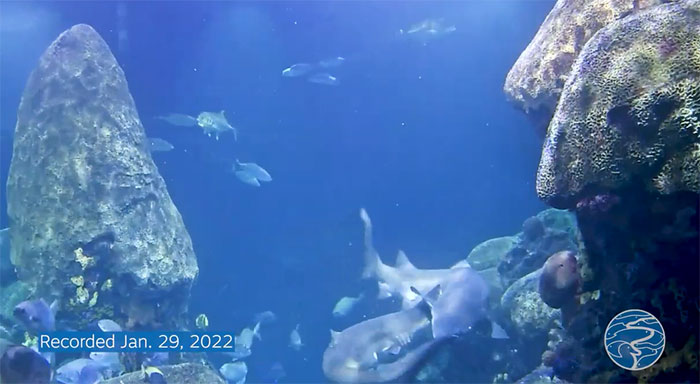The aquarium’s camera captured the moment a male sand tiger shark bit the female’s body, a behavior commonly observed during mating.
The camera continuously operated in the Secret Reef exhibit at the Tennessee Aquarium in the United States, recording a pair of sand tiger sharks mating on January 29. In the video, the male shark shows affection to the female by using its teeth.
The male shark’s “love bites” are relatively intense. The male uses its jaws and teeth to hold the female in place. This interaction may appear somewhat rough, especially for inexperienced sharks, and can leave marks on the female’s fins and body. However, they are prepared for this interaction.
“When facing the same direction, the male shark typically bites the female at the large dorsal fin and then wraps its body around her. It looks quite aggressive, but this is how these sharks reproduce. They are built for this. The female’s skin consists of tough scales and can be much thicker than the male’s. They sustain some injuries during mating, but they are usually superficial and will heal,” said Thom Demas, the aquarium director.

Two sand tiger sharks pairing up.
The team of experts at the aquarium is monitoring for signs that the mating efforts have been successful and that the female is pregnant. If so, they could welcome new members in about 9 to 13 months.
The baby sharks will develop in the mother’s womb before being born and swimming around. Inside the womb, the larger sharks will cannibalize their weaker siblings for nutrients. This means that sand tiger sharks may have killed their first prey even before being born.
Although they produce strong and capable offspring, in-womb cannibalism leads to low reproductive rates. Sand tiger sharks are among the least reproductive shark species. This is concerning for a species classified as critically endangered since 2020, like the sand tiger shark. Therefore, their pregnancy and reproduction in captivity is encouraging news.
“The pairing occurs without human assistance and is simply the result of good care and nutrition, along with a healthy living environment. This is a positive sign indicating the feasibility of reproduction in a suitable artificial environment. It’s fantastic for sand tiger sharks, as our goal is to care for them, help protect them, and compensate for their decline in the wild,” Demas explained.


















































